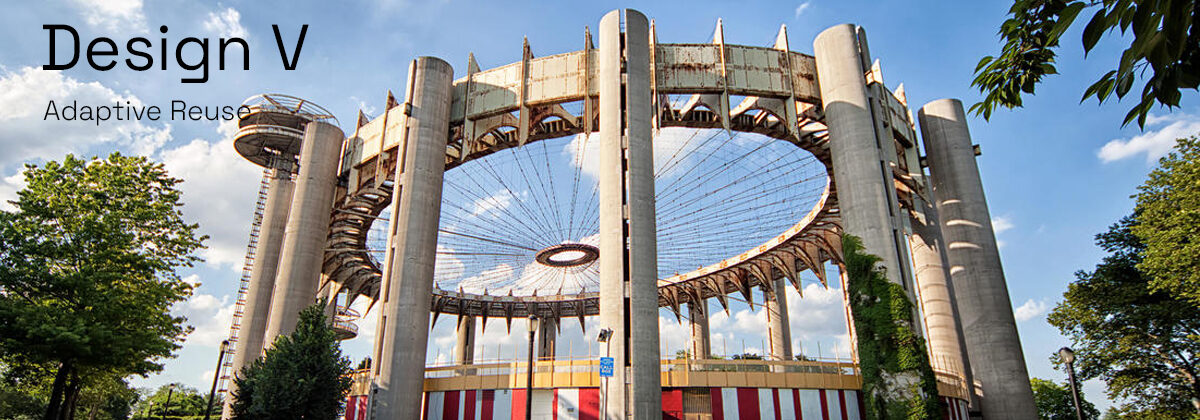Adaptive Reuse: Conversion of an existing building into a commercial space.
You are being hired to transform and give new life to the ruins of the 1964 World’s fair.The structure located in Flushing meadows Queens was designed by Philip Johnson
The Pavilion is a monumental concrete and steel structure combining a theater, three observation towers, and a 100-foot high, open-air elliptical ring. Even in its current deteriorated state, the Pavilion remains a focal point of a 1,255-acre urban landscape that is Queens’ largest green space. It is Owned by the city and administered by the Parks Department, the Pavilion is structurally stable, but needs critical repairs and restoration.
https://www.youtube.com/watch?v=D2sDTeIVrvM
https://www.youtube.com/watch?v=6pKRRb28nG0
Your challenge is to revitalize the abandoned building and design a boutique hotel that serves the community.
Boutique Hotel
The definition of a boutique hotel varies, especially among the hotel industry’s primary players. However, most boutique hotel operators, creators, and owners can all agree on the following primary features of boutique hotels:
- Unique in design
- Properties that do not exceed 150 rooms.
- They generally target customers who are in their early 20s to mid-50s, with mid- to upper-income averages.
- Personalized Service
The project will be divided into two Phases.
Phase 1 will concentrate on research and process developing the bulk of the boutique hotel. We will explore
- Additive process to create space that would be viable for living and space organization
- Design Alternatives for manipulating the existing structure
- Design solutions based on site/program strategies
You will be able to carve three-dimensional space within this existing structure.
The existing structure cannot be torn down.
Phase 2 will focus on developing the interior spaces of the boutique hotel, with concentration on the lobby, the bathrooms, and the unique space you decide appropriate for your boutique hotel based on your theme.
All these spaces are a combination of many small parts including the layout, furniture, lighting, color scheme and more. It is how all of these come together that defines the overall image of the boutique hotel.
To begin, you will choose the theme of your hotel that will be incorporated into the program of the hotel. This will be determined after a thorough site analysis.
Then you will study precedents, generate parti material, and program the space. You will demonstrate your process with abstracts, sketches, diagrams, and models. Your final design will be presented digitally with plans, sections, elevations, renderings and with physical model.
Your design will be required to follow all code requirements and ADA regulations. All site improvements should be designed to help the overall performance of the building and must meet building codes and zoning regulations
The scope of the design work will include:
- Public and Private spaces as define by your program, including typical spaces such as lobby, reception, café/bar, lounge, storage, offices, luggage storage, mechanical, vertical circulation, laundry, housekeeping, public bathrooms…
- Circulation,
- Vehicular Access
- Pedestrian access
- Bicycle access
- Service Entrance. -Loading dock
- Egress, façade, fenestration, etc.
- All floor, wall, ceiling, and component materials
- Furniture layout
- Lighting, Media, and Graphics
The new hotel should include but not limited to:
-
- Lobby / Reception 1,000 sf minimum
- *include adj.100 sf office
- Lobby bar/café/retail/gallery 2,000 sf
- Lobby level public washrooms (2) 80 sf each. *single occupancy ADA type
- Public Corridors 5 feet width, min., as required
- Ceremonial Stair or Ramps as req’d
- Fire Stair (2) as req’d
- Passenger Elevators (2)
- Service / Freight Elevator (1). *must be accessed through closed. service rooms @ each level
- 18-25 typical (standard) guest rooms 10,500 total sf (approx.)
- 1 ‘penthouse’ unit 1,000 sf
- *provide designated living/sleeping areas
- *must include guest powder room
- *must include dressing area/room & full bathroom
- *must include a small kitchen
- Lobby / Reception 1,000 sf minimum
- Fitness Center (otional) 600 sf or as req’d
- ‘Mid-Level’ venue(s) 300 to 600 sf each
- *spaces that provide group socializing
- opportunities adjacent to private rooms
- *total number to be determined by designer
-
- Rooftop Venue (select) 2,000 sf
*Café, Gallery, Event Space, Nightclub, Pool Deck, Spa, etc. or combination
- Administrative Offices 500 sf
- Storage Room / Housekeeping 200 sf
- Storage Room / Food Service/Cafe 200 sf
- Storage Room / General 300 sf
- Laundry Room 300 sf
- Trash Room 200 sf
- Janitor Room 40 sf per floor (room). *1 per floor w/ 3’ x 3’
Circulation 40%
Final Presentation Requirements:
What describes your project Best?
Minimum Requirements:
-
- Site Strategy Board derived from you extensive Site Analysis Group Project
- Concept board with the name and logo of the hotel
- Bubble Diagram and Matrix
- Site plan providing Context
- All Floor Plans (plans must show furniture layout)
- Exterior Elevations
- Interior elevations/Sections (minimum 2)
- 3-Dimentional images (interior and exterior) and physical model placed in class site model.
- Lighting layout/RCP
- There must be outdoor space incorporated into your design
- Mood Bords
Requirements:
-
- Mechanical spaces must be located above the floor plain.
- There must be two enclosed fires stairs that lead directly outside – to Union Street or the Canal.
- You can create new openings in the façade but cannot remove more than 33% of any side.
- An Architectural stair can be open and connect various levels within your Lobby. Each level must be able to be reached by elevator. This stair does not count towards one of the required fire escapes.



